Subscribe to blog updates via email »
Surround and Conquer (Your Biggest Dreams) – Love Your Work, Episode 280
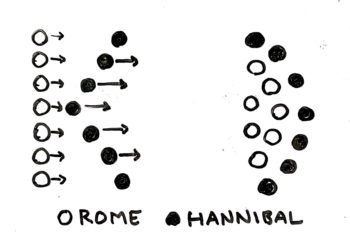 When Facebook was first expanding, they used a timeless military strategy to win their most-crucial first users. You can use this strategy to attack your toughest projects, by leveraging hidden complexity to lend devastating power to simple actions.
When Facebook was first expanding, they used a timeless military strategy to win their most-crucial first users. You can use this strategy to attack your toughest projects, by leveraging hidden complexity to lend devastating power to simple actions.
Listen to the Podcast
- Listen in iTunes >>
- Download as an MP3 by right-clicking here and choosing “save as.”
- RSS feed for Love Your Work
Facebook faced tough competitors
When Facebook was starting, in the mid-aughts, it was only available at colleges. It wasn’t easy to win new users on campuses that had their own social networks. Who wants to join the network nobody is on? That’s not where you find the big parties. That’s not how you spy on your crush.

WANT TO WRITE A BOOK?
Download your FREE copy of How to Write a Book »
(for a limited time)
There was no point in promoting to students who already had better alternatives. Facebook would waste their limited resources, driving themselves out of business. There were plenty of competitors they needed to outlast.
An established network at a college was a barrier to winning over any user at that college – a “defense,” if you will. Facebook needed to break through those barriers.
The surround strategy: Attack from the flanks
So they used what they called a “surround strategy”. Instead of directly trying to get users on a given campus, they got them indirectly.
The strategy that decimated the Roman army 1800 years ago
Facebook’s surround strategy was borrowed from the “pincer” military strategy. When you’re up against an opponent with strong defenses, it’s often not the best use of your resources to attack them head-on. It’s better to focus on the flanks.
Hannibal used a pincer strategy in one of the greatest military upsets in history, at the Battle of Cannae, in 216 B.C., sending the Roman empire into a panic. As the Romans attacked from a concentrated center, the center of Hannibal’s forces fell back, creating a “crescent” shape that helped them attack the flanks. Eventually, Hannibal had the Romans surrounded.
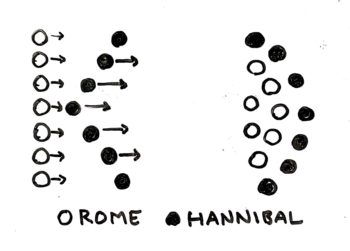
Hannibal used a surround strategy to defeat the Roman army.
The Romans lost so many men that day, they had to lower the draft age to replenish their forces, and they reverted to using human sacrifices to try to please the gods.
How Facebook won key users indirectly
Facebook used this pincer strategy to indirectly win users at Baylor University, in Texas, which already had its own social network. Instead of promoting Facebook to users at Baylor, they focused on campuses near Baylor
There weren’t already competing social networks at UT Arlington, a one and a half-hour drive to the north; Southwestern University, a one-hour drive to the southwest; and Texas A&M, a one and a half-hour drive to the southeast.
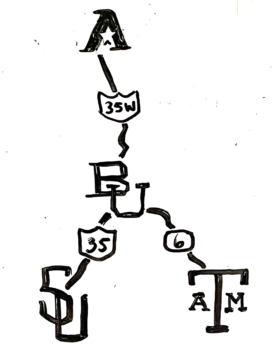
To win users at Baylor, Facebook focused on surrounding universities.
To get the dirt on their exes, they needed to be on Facebook
While Facebook wasn’t wasting resources trying to get Baylor students to switch social networks, those students started to hear about Facebook, anyway. The students in these surrounding colleges were former high-school classmates of the Baylor students. They were driving to one another’s campuses to bong beers and eat jello shots. They were hearing rumors their high-school sweethearts were getting naked with half the campus. They were laughing maniacally upon hearing the former bully was found passed out, naked with an armadillo.
To get the dirt, to creep on one another’s profiles, or, sometimes to just stay in touch, they too needed Facebook accounts. So, without any promotion at Baylor, Facebook started winning users at Baylor.
The birthday problem reveals the hidden complexity that make the surround strategy work
This surround strategy works better than people expect it to. To understand why, think about the birthday problem, which I talked about on episode 237. How many people have to be in a room for a fifty-percent chance two of them have the same birthday? Most people guess 180 or 150, but the real answer: only twenty-three.
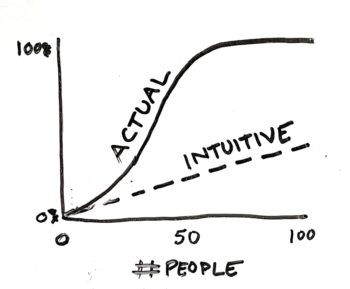
As you add people to a room, the chances of a shared birthday increase much faster than expected.
The odds of shared birthdays climb rapidly as you add the first few dozen people to the room. Network effects between each person’s potential birthdates quickly add potential matches. Adding one person to a room of twenty people doesn’t add just one potential match, it adds twenty.

Network effects rapidly increase potential connections, even when only a single node is added.
Network effects…outside the network
Facebook’s surround strategy leveraged these network effects. The colleges they focused on didn’t have social networks, so Facebook quickly became very appealing, as they added users.
Meanwhile, Facebook also became more appealing to the students at Baylor. Who wants to use a social network that only has students from your college?!
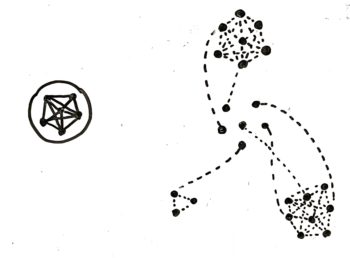
Once Facebook took hold in surrounding campuses, network effects ensured Baylor was no longer an impenetrable territory.
With each new user Facebook added in a neighboring campus, they added multiple contacts to potential new users at Baylor. After someone heard about Facebook enough times, they had to sign up.
As Hannibal’s men surrounded Rome’s, there were more angles from which each soldier on Hannibal’s front could attack soldiers on Rome’s front, but not vice-versa. A complementary strategy to the pincer is also the “pocket,” or isolating small portions of a battalion to conquer them bit by bit.
Surround & conquer your dreams
Now, how can you use this surround strategy on some of your biggest and most-intimidating visions? When you want to accomplish something that’s too big to attack head-on, use the surround strategy to break down the project’s defenses.
Here’s how to surround, and conquer, your toughest projects:
- Make a list of all the things you’d need to know or have to accomplish your goal.
- Brainstorm ways you could learn those skills or gain those resources with smaller projects.
- Take on the smaller projects that are most interesting to you, or that use your existing resources.
As you take on these smaller projects related to your target project, network effects take over. The skills and resources you gain will make the larger project seem easier than it would otherwise, and you get some successes to build your confidence along the way, and learn the skill of shipping, like I talked about on episode 265.
Surround & conquer Shakespeare
Here’s a very simple example: Let’s say you want to read a Shakespeare play, but you can’t keep track of what everyone is saying in that language that doth make one scratch one’s head. Do this:
- Watch the movie.
- Read the Wikipedia page.
- Listen to the podcast.
- Finally, read the play.
By staking out the easier-to-conquer territory in your mind, it’s easier to conquer the more-fortified territory, and run back for supplies – or a reminder of what the heck is going on, based upon the other ways you’ve heard the story.
How creators surround & conquer
Other creators use the surround strategy, whether they say so, or not.
- Before the Steves Jobs and Wozniak built their first Mac, they worked on “blue boxes” they used to tap into phone networks and make prank calls. It was just a fun and mischievous and illegal project, but it helped build their collaborative relationship on something smaller and less complex.
- Henry Ford got a job working on steam engines, while running experiments in his garage to perfect the internal combustion engine. He made a living gaining the background he needed, and making connections with potential investors, while on nights and weekends he tinkered on the finer details.
- Michelangelo didn’t paint the Sistine Chapel ceiling from scratch. He had libraries of plaster-casted drapery and terra cotta body parts he mixed and matched to draw compelling figures in his scenes.
How I use the surround strategy
I, personally, use the surround strategy whenever I can. For example, I want to write fiction, though I’m not a huge fiction reader myself. But, I do like movies.
So, I’ve been reading screenplays of my favorite movies and reading the novels those movies are based upon, while dabbling in short stories under a pen name, and working on my storytelling skills in my non-fiction writing whenever possible. I’m learning to love fiction, while working on my fiction-writing skills.
In fact, all my work is a surround strategy for conquering new books. Each of my tweets, my weekly Love Mondays newsletters, my podcast episodes and articles and notes in my Zettelkasten, are experiments with progressively larger ideas, the best of which build into a book every few years or so.
Go forth and conquer
The next time you’re dreaming about something that seems impossible, surround it with projects that are possible. Then, your bigger dreams will be easier to conquer.
Join the Patreon for (new) bonus content!
I've been adding lots of new content to Patreon. Join the Patreon »
Subscribe to Love Your Work
Listen to the Podcast
- Listen in iTunes >>
- Download as an MP3 by right-clicking here and choosing “save as.”
- RSS feed for Love Your Work
Theme music: Dorena “At Sea”, from the album About Everything And More. By Arrangement with Deep Elm Records. Listen on Spotify »


